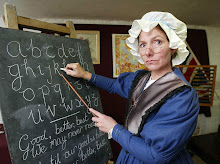The dunce cap comes from a 13th-century philosopher named John Duns Scotus, who, not surpisingly, was born in Duns, Scotland. This well-respected but terribly oblique scholar felt that conical hats actually increased learning potential. Here's the theory -- knowledge is centralized at the apex and then funneled down into the mind of the wearer.
So the logic behind the dunce cap is that it makes slow pupils learn better, but it was later used to humiliate the wearer and motivate students to try harder.

Some of the rules my students must follow or receive raps on the hand with a ruler or they are sent to the corner with a dunce cap on their heads.
1.Students must stand up to answer questions and wait for permission to speak.
2.Students must call teachers "Sir" or "Ma'am".
3.Students must stand when an adult enters the room.
4.Students must use the right hand at all times for writing.
5.Girls will learn needlework and boys will learn technical drawing.
6.Prizes will be given for good attendance.
7.Students must not raise their hands, unless told they can do so.
8.Students must not ask questions.
9.Talking and fidgeting will be punished.
10.Children who are truant (late), behave badly or do poor work will be caned.







